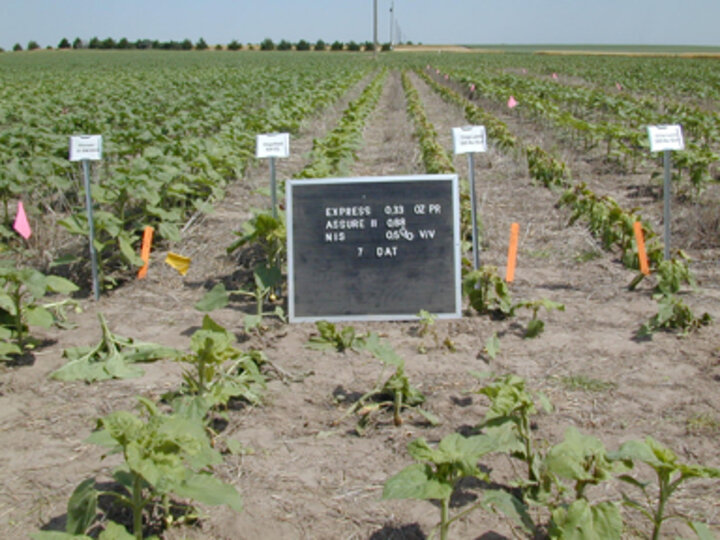May 4, 2007
Weed control in sunflower begins with placing sunflower in a rotation where warm-season broadleaf weeds are easily and well controlled in the previous crop. Sunflower is usually planted at lower densities than many other crops and grows slowly during the first two to three weeks. Weeds that emerge and establish during this time can be very competitive and reduce sunflower yield potential tremendously; however, sunflower is a strong competitor with weeds that emerge three or more weeks after sunflower emergence. Therefore, maintaining sunflower weed free for the first three to four weeks after planting will minimize yield losses from weeds.
Pre-emergence Herbicides
|
With the exception of Spartan, soil-applied herbicides primarily control grassy weeds such as foxtail, sandbur, stinkgrass and witchgrass. All these herbicides provide some control of small-seeded broadleaf weeds such as pigweed and lambsquarters. At higher use rates, they also can control kochia and Russian thistle. Spartan provides control of pigweed species, kochia, Russian thistle and lambsquarters. Spartan should be tank mixed with a herbicide that will control grasses to obtain optimum weed control. Some crop injury has been reported from using Spartan. The injury is typically restricted to high pH, low organic matter soils and consists of leaf chlorosis, plant stunting and occasionally plant death. Injured plants generally grow out of the injury within a few weeks and yield differences are minimal at harvest.
Postemergence Herbicides
Imazamox (Beyond) is labeled for use only in Clearfield sunflower hybrids. Clearfield sunflower hybrids contain a gene that confers tolerance, not resistance, to Beyond herbicide. Some slight crop injury (leaf yellowing and plant stunting) may be observed following Beyond herbicide application to Clearfield sunflower hybrids, especially where overapplication occurs such as in spray overlaps or field ends. Injured plants often recover quickly. Non-Clearfield hybrids would be killed if treated with Beyond herbicide.
Beyond herbicide should be applied early postemergence at a rate of 4 oz of product per acre to sunflower with two to eight leaves. Weeds should be actively growing at the time of application and broadleaf weeds should be less than 3 inches tall. Grass weeds should have no more than four to five leaves. A nonionic surfactant and nitrogen-based fertilizer must be added to the spray solution for optimum weed control. It is recommended that a soil applied grass herbicide, such as Prowl or Dual Magnum be applied prior to the application of Beyond herbicide. Beyond herbicide will control many of the broadleaf weeds that are troublesome in Nebraska sunflower fields including pigweed, kochia, Russian thistle and nightshade. Beyond inhibits ALS-AHAS synthesis in weeds and will not effectively control ALS-resistant kochia or Russian thistle. There is also some concern about the risk of transferring the gene conferring tolerance to Beyond herbicide from commercial sunflower hybrids to wild sunflower. This technology should be avoided in fields where wild sunflower is present.
Tribenuron (Express) is labeled for use only in Express Sun sunflower hybrids. These hybrids contain a gene that confers tolerance to Express herbicide. Some slight yellowing or stunting may be observed after Express is applied to Express Sun hybrids, particularly if over application occurs. Injured plants often recover quickly. Express Sun hybrids are not cross-resistant to ALS herbicides or other sulfonylurea herbicides. Application of other ALS herbicides to Express Sun hybrids will result in serious crop injury or death.
Apply Express herbicide to sunflower anytime from the one-leaf stage but prior to bud formation when broadleaf weeds are less than three inches tall. Express does not control grass weeds or ALS-resistant weeds. Use a soil-applied or postemergence grass herbicide if grass weeds are a concern. Research in North Dakota indicates that Express may antagonize postemergence grass herbicides if applied together. We have not observed this in Nebraska, but our grass pressure has been light. Apply Express with MSO-type oil adjuvants at 1% v/v for best results. Express provides control or suppression of Canada thistle. As mentioned for Beyond, this technology should be avoided in fields where wild sunflower is present.
Other Herbicides. The other postemergence herbicides used in sunflower are sethoxydim (Poast), quizalafop (Assure II, Targa) and clethodim (Select, Select Max). These herbicides control emerged grass weeds and volunteer small grains.
Drew Lyon
Dryland Cropping Systems Specialist
Robert Wilson
Weeds Specialist
Both at the Panhandle REC, Scottsbluff


